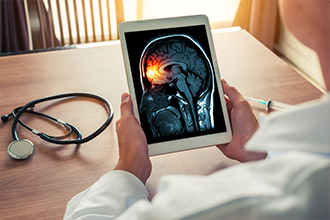Artificial Intelligence and Imaging Techniques to Help Detect Meningitis

21 Jul
2022
Acute bacterial meningitis has been a source of concern for over many years. Meningitis is a neurological illness that is caused by inflammation of the brain and spinal cord and may lead to neurological disabilities and even death. It shows a few common symptoms such as fever, stiff neck, and headache. Thus, it is very important that healthcare professionals perform a diagnostic test to confirm the disease and it’s because of it. Meningitis can be caused due to bacterial or viral infection. If it is bacterial meningitis, the patients may have to deal with chronic pain. In this case, meningitis bacteria enter the bloodstream and travel to the brain, which can lead to several health issues such as deafness, learning disability, and brain damage. On the other hand, viral meningitis is less severe compared to bacterial meningitis but it has no defined set of treatments. Thus, imaging helps to understand the progress of meningitis and whether it has affected bones, blood, tissues, and other vital organs.
Rise in prevalence of meningitis disease, advancements in meningitis imaging market technology, and surge in use of artificial intelligence (AI) and augmented reality (AR) drive the market growth.
For diagnostic purposes, the magnetic resonance imaging (MRI) method is used. The process involves the use of strong magnets and radio waves to create a picture of the body. MRI provides a comprehensive image of the progression of the disease compared to traditional CT scans. In addition, MRI can detect inflammation in the brain or spinal cord and warn about the possibility of a tumor, eye disease, or any other underlying diseases.
Over the last few years, MRI technology has advanced a lot. Moreover, there are no tests to confirm the cause of meningitis within 24 hours. However, the case of bacterial meningitis can be deadly, and thus, there is a dire need for faster diagnostic tests. There are some rapid tests to confirm the disease but they lack reliability and are quite costly. Thus, even today, the diagnosis of meningitis depends on imaging techniques and the expertise of a healthcare professional.
Having said that, AI technology has developed rapidly and has proven effective in diagnosis. Several teams of researchers have attempted to harness the power of AI and machine learning (ML) in the differential diagnosis of meningitis. With the colossal data collected by patient health records, it is possible for AI and ML algorithms to find patterns and notify doctors about early signs of bacterial meningitis. However, the technology to use AI in the detection of meningitis is still in its infancy and needs a lot of research and clinical trials. It offers a unique opportunity to detect chronic illnesses such as meningitis as early as possible and offer the patient a fighting chance.

Koyel Ghosh
Author’s Bio- Koyel Ghosh is a blogger with a strong passion and enjoys writing in miscellaneous domains, as she believes it lets her explore a wide variety of niches. She has an innate interest in creativity and enjoys experimenting with different writing styles. A writer who never stops imagining, she has been serving the corporate industry for the last five years.
Avenue: Entire Library membership of Allied Market Research Reports at your disposal
- Avenue is an innovative subscription-based online report database.
- Avail an online access to the entire library of syndicated reports on more than 2,000 niche industries and company profiles on more than 12,000 firms across 11 domains.
- A cost-effective model tailored for entrepreneurs, investors, and students & researchers at universities.
- Request customizations, suggest new reports, and avail analyst support as per your requirements.
- Get an access to the library of reports at any time from any device and anywhere.
Related Post
-
How are Submarine Cables Transforming Global Connectivity with Enhanced User Experience?
-
Endoscopy Procedures: Transformations in Techniques and Applications
-
AI-Powered Video Analytics: How the Product Actually Works for enterprises
-
Painting Robots: Transforming Precision Coating and Creative Applications
-
Innovations in Pharmacovigilance Systems Advancing Patient Safety
-
Understanding Edge Security: Keeping Data Safe Near the Source
-
Exploring the Use and Advancements of 3D Laser Scanners in Professional Applications
-
Reinforcing Industrial Controls with Smarter Tools and Training








